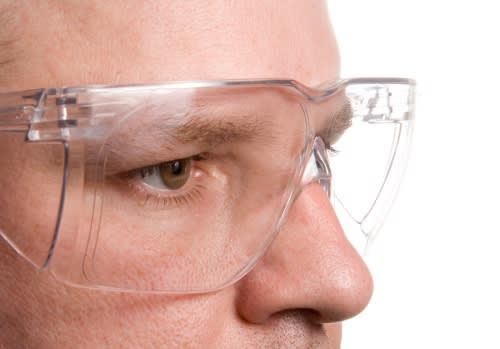-
How Do IOLs Work?
If you are considering cataract surgery, then your ophthalmologist may recommend that you consider eye surgery in Chicago to get intraocular implants . Watch this video to learn about how this type of vision correction works.
Sometimes referred to as an intraocular lens or IOL, an intraocular implant works like your eye’s natural lens by focusing the light that penetrates the cornea and pupil to help you see. The IOL focuses light onto your retina at the back of the eye, and the retina then transforms the light into signals that travel through the optic nerve to the brain, where they are rendered into the images that you see. In this way, IOLs can improve a range of vision problems.
-
Tips for Avoiding Household Eye Injuries
When it comes to practicing good eye care in Chicago , this means more than just visiting your optical center for regular exams with you eye doctor. Caring for your eyes involves taking certain precautions when necessary to help protect your vision, and this includes when you are at home. There are several things that you can do to help avoid household eye injuries.
If you ever use hazardous chemicals or products around the house, then eye doctors recommend that you protect your eyes from injury by wearing protective eye gear. Also, if you ever work with power or hand tools, bungee cords and loads, lawn mowers, or hedge trimmers, then these are all situations in which you should be cautious about fragments injuring your eyes and in which you can benefit from using protective eyewear. Finally, take care in the kitchen while preparing anything with oil or hot liquids to prevent them from splattering and causing eye injuries.

-
A Look at the Three Types of Glaucoma
Are you wondering if you need to see an eye doctor for vision correction in Chicago because of your deteriorating eyesight? If so, then you may benefit from knowing more about glaucoma, which refers to several eye diseases that affect the optic nerve. Continue reading to learn about the types of glaucoma.

Open-Angle Glaucoma
The most common form of glaucoma in the United States and Canada, open-angle glaucoma (OAG) is characterized by worsening sight in both eyes that usually occurs slowly and even unnoticeably. In the case of OAG, the symptoms develop so slowly that it’s not uncommon for them to go unnoticed until the person’s vision is severely deteriorated. Often, this is because one eye can be more affected than the other and the one that’s in better condition makes up for the discrepancy. With open-angle glaucoma, peripheral eyesight tends to deteriorate before the central vision.
Closed-Angle Glaucoma
Less common in the United States and Canada than OAG and affecting only one eye, closed-angle glaucoma (CAG) can come on suddenly and can even result in a medical emergency. However, CAG symptoms can also be mild and can cause blurry vision that comes and goes and is short-term. When severe, the signs of CAG can include episodes of blurred vision that last for longer periods and can include pain that’s felt around or in the eye. Some other symptoms of closed-angle glaucoma include nausea, red eyes, and seeing colorful halos around lights. If you notice that your vision is suddenly blurry, see an ophthalmologist at an eye care center right away.
Congenital Glaucoma
Occurring in infants at birth and sometimes in children and young adults, congenital glaucoma is the rarest type of this eye disease. An individual suffering from this condition may have symptoms that include eyes that water a lot and are sensitive to the light. If a child has congenital glaucoma, you may notice that she often squints, closes her eyes, or rubs her eyes. If you notice these behaviors in your baby, she should be seen by an eye doctor as soon as possible.
-
A Look at the Connection Between Diabetes and Eye Health
November marks the beginning of National Diabetes Month and Diabetic Eye Disease Month. These health awareness designations are intended to encourage individuals to become informed of their own health risks and the potential consequences of poorly controlled diabetes. In recognition of these designations, take the time to check the date of the last comprehensive eye exam you had at an optical center in Chicago . If it’s been more than one year, it’s time for another visit with your ophthalmologist.

Diabetes
Diabetes is a serious disease that can lead to life-altering and life-threatening complications, including eye health problems. Diabetes occurs when the body can no longer make enough insulin or use insulin properly, which results in high blood sugar levels. Over time, high blood sugar levels can cause all sorts of damage to the body, including to the optic nerve and the tiny blood vessels in the eyes. Unfortunately, many people have diabetes or prediabetes without realizing it. In addition to making regular appointments with an ophthalmologist, consider talking to your family physician about blood glucose screenings.
Diabetic Retinopathy
Practicing good eye care habits is important, but so too is controlling blood glucose levels carefully. Uncontrolled diabetes greatly increases the risk of diabetic retinopathy, which causes the blood vessels in the eyes to swell, leak blood and other fluids, and close off entirely. Abnormal new blood vessels can also form; these do not work properly and they may be accompanied by scar tissue development. If you experience blurry vision or floaters, see your eye doctor promptly.
Cataracts
The lens of a healthy eye focuses light on the retina, which allows for clear vision. If the lens becomes cloudy, it cannot focus light properly and so vision becomes distorted. A cloudy area of the lens is called a cataract. Diabetes increases the risk of cataract development because high blood sugar levels can result in undesirable changes to the lens.
Glaucoma
Glaucoma is a collection of eye diseases that are strongly associated with increased intraocular pressure, or pressure within the eye. These diseases develop as damage is inflicted on the optical nerve. The longer a person lives with diabetes, the higher the risk is of developing glaucoma.
